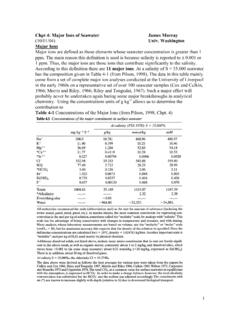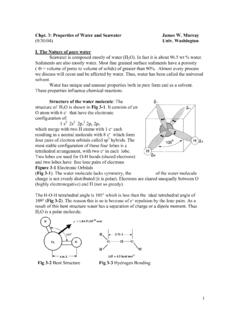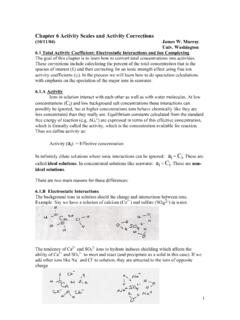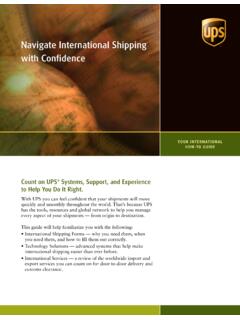Transcription of IMO | ISM Code - University of Washington
1 Home Our Work Human Element Safety Management ISM CodeISM Code and Guidelines on Implementation of the ISM Code 2010 International Safety Management CodeResolution (18) as amended by (73), (79), (80) (85) PREAMBLE1 The purpose of this Code is to provide an international standard for the safe management andoperation of ships and for pollution The Assembly adopted resolution (XI), by which it invited all Governments to take thenecessary steps to safeguard the shipmaster in the proper discharge of his responsibilities with regard tomaritime safety and the protection of the marine The Assembly also adopted resolution (17), by which it further recognized the need forappropriate organization of management to enable it to respond to the need of those on board ships toachieve and maintain high standards of safety and environmental Recognizing that no two shipping companies or shipowners are the same, and that ships operate undera wide range of different conditions, the Code is based on general principles and The Code is expressed in broad terms so that it can have a widespread application.
2 Clearly, differentlevels of management, whether shore-based or at sea, will require varying levels of knowledge andawareness of the items The cornerstone of good safety management is commitment from the top. In matters of safety andpollution prevention it is the commitment, competence, attitudes and motivation of individuals at alllevels that determines the end result. PART A IMPLEMENTATION 1 GENERAL Definitions The following definitions apply to parts A and B of this International Safety Management (ISM) Code means the International Management Code forthe Safe Operation of Ships and for Pollution Prevention as adopted by the Assembly, as may be amendedby the Company means the owner of the ship or any other organization or person such as the manager, orthe bareboat charterer, who has assumed the responsibility for operation of the ship from the shipownerand who, on assuming such responsibility, has agreed to take over all duties and responsibility imposedby the Administration means the Government of the State whose flag the ship is entitled to Safety management system means a structured and documented system enabling Companypersonnel to implement effectively the Company safety and environmental protection Document of Compliance means a document issued to a Company which complies with therequirements of this Code.
3 Related Links Purchase the ISM CodeIMO | ISM of 710/25/12 9:53 Safety Management Certificate means a document issued to a ship which signifies that theCompany and its shipboard management operate in accordance with the approved safety Objective evidence means quantitative or qualitative information, records or statements of factpertaining to safety or to the existence and implementation of a safety management system element,which is based on observation, measurement or test and which can be Observation means a statement of fact made during a safety management audit and substantiatedby objective Non-conformity means an observed situation where objective evidence indicates thenon-fulfilment of a specified Major non-conformity means an identifiable deviation that poses a serious threat to the safety ofpersonnel or the ship or a serious risk to the environment that requires immediate corrective action or thelack of effective and systematic implementation of a requirement of this Anniversary date means the day and month of each year that corresponds to the date of expiryof the relevant document or Convention means the International Convention for the Safety of Life at Sea, 1974, as amended.
4 Objectives The objectives of the Code are to ensure safety at sea, prevention of human injury or loss of life,and avoidance of damage to the environment, in particular to the marine environment and to Safety management objectives of the Company should, inter alia: .1provide for safe practices in ship operation and a safe working environment;.2assess all identified risks to its ships, personnel and the environment and establish appropriatesafeguards; improve safety management skills of personnel ashore and aboard ships, includingpreparing for emergencies related both to safety and environmental protection. The safety management system should ensure: .1compliance with mandatory rules and regulations; applicable codes, guidelines and standards recommended by the Organization, Administrations,classification societies and maritime industry organizations are taken into account. ApplicationThe requirements of this Code may be applied to all Functional requirements for a safety management systemEvery Company should develop, implement and maintain a safety management system which includesthe following functional requirements.
5 1a safety and environmental-protection policy;.2instructions and procedures to ensure safe operation of ships and protection of the environment incompliance with relevant international and flag State legislation;.3defined levels of authority and lines of communication between, and amongst, shore and shipboardpersonnel;.4procedures for reporting accidents and non-conformities with the provisions of this Code;.5procedures to prepare for and respond to emergency situations; for internal audits and management reviews. 2 SAFETY AND ENVIRONMENTAL-PROTECTION POLICY The Company should establish a safety and environmental-protection policy which describes howthe objectives given in paragraph will be The Company should ensure that the policy is implemented and maintained at all levels of theorganization, both ship -based and shore-based. 3 COMPANY RESPONSIBILITIES AND AUTHORITYIMO | ISM of 710/25/12 9:53 AM If the entity who is responsible for the operation of the ship is other than the owner, the owner mustreport the full name and details of such entity to the The Company should define and document the responsibility, authority and interrelation of allpersonnel who manage, perform and verify work relating to and affecting safety and pollution The Company is responsible for ensuring that adequate resources and shore-based support areprovided to enable the designated person or persons to carry out their functions.
6 4 DESIGNATED PERSON(S) To ensure the safe operation of each ship and to provide a link between the Company and those on board,every Company, as appropriate, should designate a person or persons ashore having direct access to thehighest level of management. The responsibility and authority of the designated person or persons shouldinclude monitoring the safety and pollution-prevention aspects of the operation of each ship and ensuringthat adequate resources and shore-based support are applied, as required. 5 MASTER S RESPONSIBILITY AND AUTHORITY The Company should clearly define and document the master s responsibility with regard to: .1implementing the safety and environmental-protection policy of the Company;.2motivating the crew in the observation of that policy;.3issuing appropriate orders and instructions in a clear and simple manner;.4verifying that specified requirements are observed; reviewing the safety management system and reporting its deficiencies to the shore-basedmanagement.
7 The Company should ensure that the safety management system operating on board the ship containsa clear statement emphasizing the master s authority. The Company should establish in the safetymanagement system that the master has the overriding authority and the responsibility to make decisionswith respect to safety and pollution prevention and to request the Company s assistance as may benecessary. 6 RESOURCES AND PERSONNEL The Company should ensure that the master is: .1properly qualified for command;.2fully conversant with the Company s safety management system; the necessary support so that the master s duties can be safely performed. The Company should ensure that each ship is manned with qualified, certificated and medically fitseafarers in accordance with national and international The Company should establish procedures to ensure that new personnel and personnel transferred tonew assignments related to safety and protection of the environment are given proper familiarization withtheir duties.
8 Instructions which are essential to be provided prior to sailing should be identified,documented and The Company should ensure that all personnel involved in the Company s safety managementsystem have an adequate understanding of relevant rules, regulations, codes and The Company should establish and maintain procedures for identifying any training which may berequired in support of the safety management system and ensure that such training is provided for allpersonnel The Company should establish procedures by which the ship s personnel receive relevantinformation on the safety management system in a working language or languages understood by The Company should ensure that the ship s personnel are able to communicate effectively in theIMO | ISM of 710/25/12 9:53 AMexecution of their duties related to the safety management system. 7 SHIPBOARD OPERATIONS The Company should establish procedures, plans and instructions, including checklists as appropriate, forkey shipboard operations concerning the safety of the personnel, ship and protection of the various tasks should be defined and assigned to qualified personnel.
9 8 EMERGENCY PREPAREDNESS The Company should identify potential emergency shipboard situations, and establish procedures torespond to The Company should establish programmes for drills and exercises to prepare for The safety management system should provide for measures ensuring that the Company sorganization can respond at any time to hazards, accidents and emergency situations involving its ships. 9 REPORTS AND ANALYSIS OF NON-CONFORMITIES, ACCIDENTS AND HAZARDOUSOCCURRENCES The safety management system should include procedures ensuring that non-conformities, accidentsand hazardous situations are reported to the Company, investigated and analysed with the objective ofimproving safety and pollution The Company should establish procedures for the implementation of corrective action, includingmeasures intended to prevent recurrence. 10 MAINTENANCE OF THE ship AND EQUIPMENT The Company should establish procedures to ensure that the ship is maintained in conformity withthe provisions of the relevant rules and regulations and with any additional requirements which may beestablished by the In meeting these requirements, the Company should ensure that.
10 1inspections are held at appropriate intervals;.2any non-conformity is reported, with its possible cause, if known;.3appropriate corrective action is taken; of these activities are The Company should identify equipment and technical systems the sudden operational failure ofwhich may result in hazardous situations. The safety management system should provide for specificmeasures aimed at promoting the reliability of such equipment or systems. These measures shouldinclude the regular testing of stand-by arrangements and equipment or technical systems that are not incontinuous The inspections mentioned in as well as the measures referred to in should be integratedinto the ship s operational maintenance routine. 11 DOCUMENTATION The Company should establish and maintain procedures to control all documents and data whichare relevant to the safety management The Company should ensure that.










